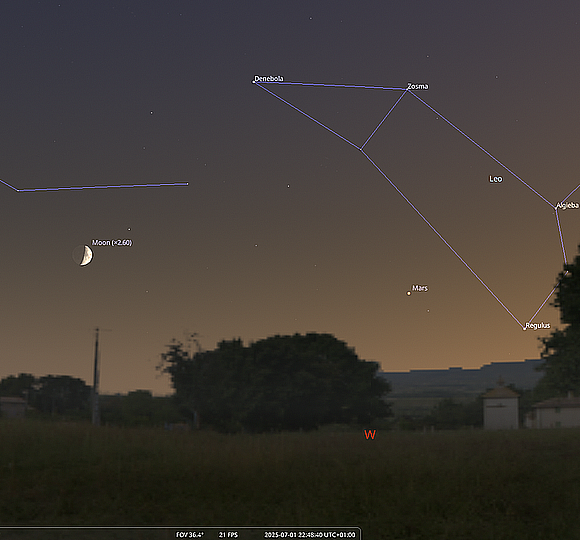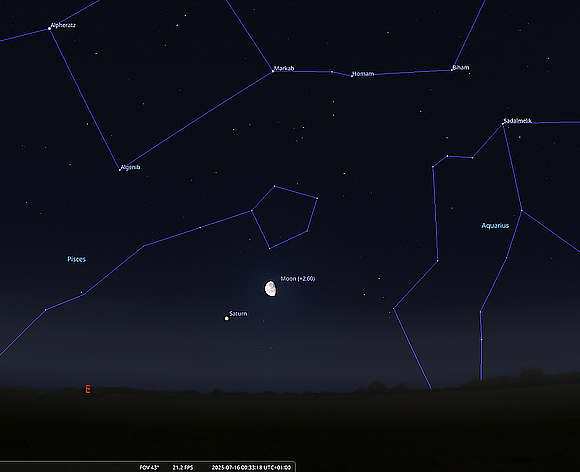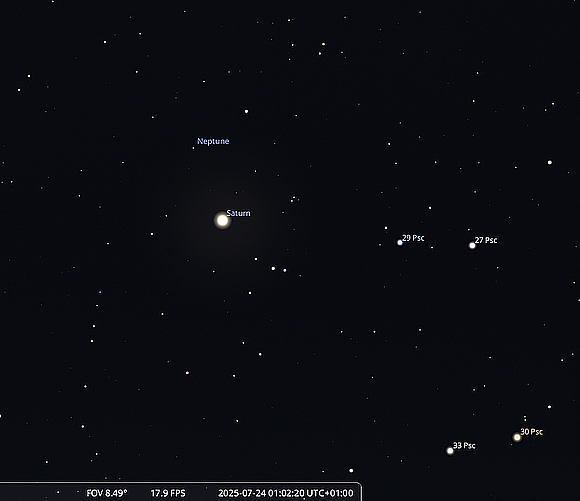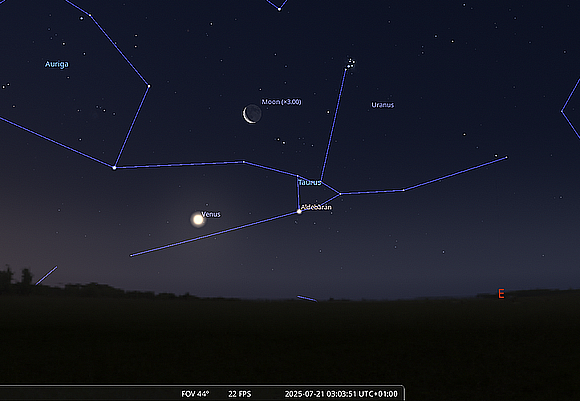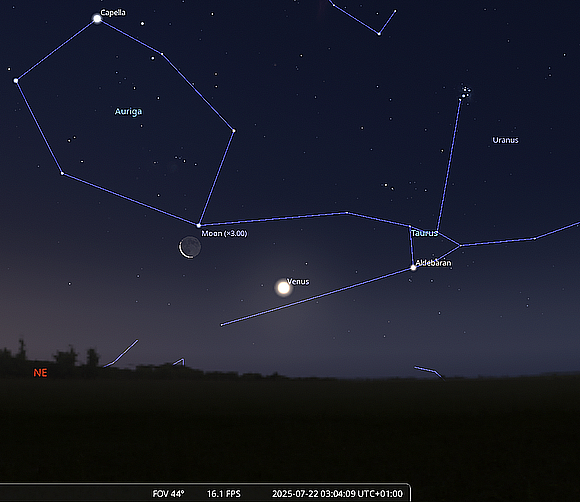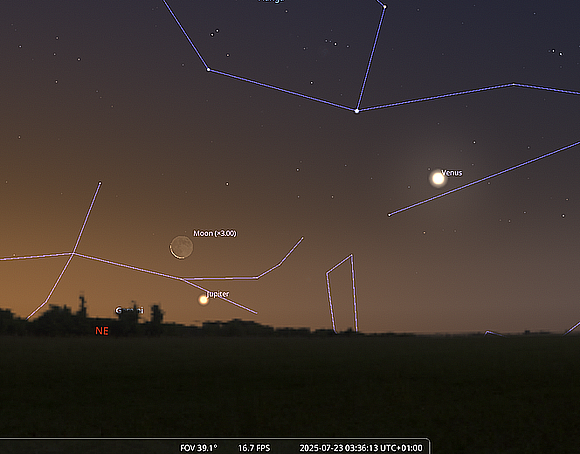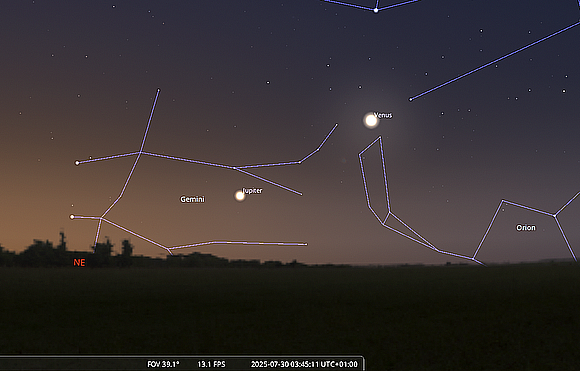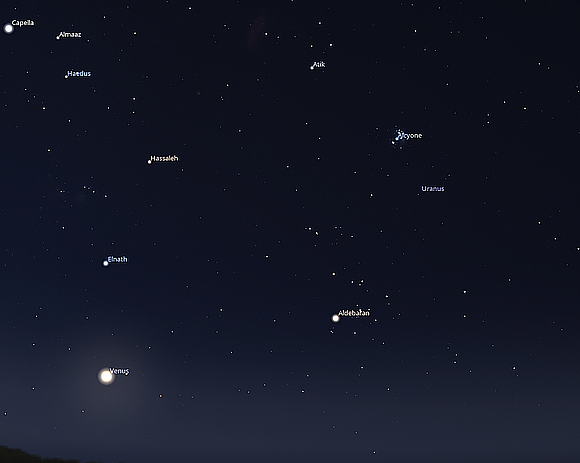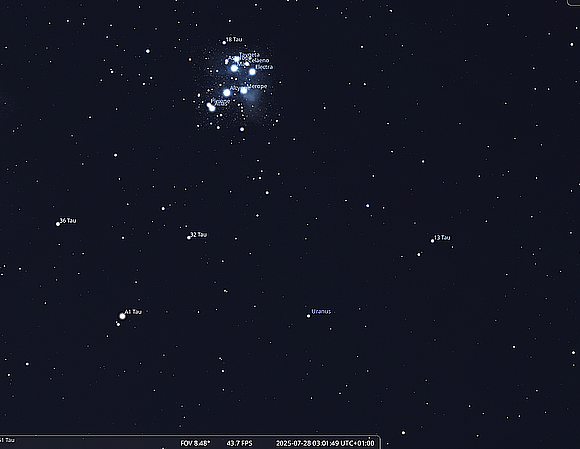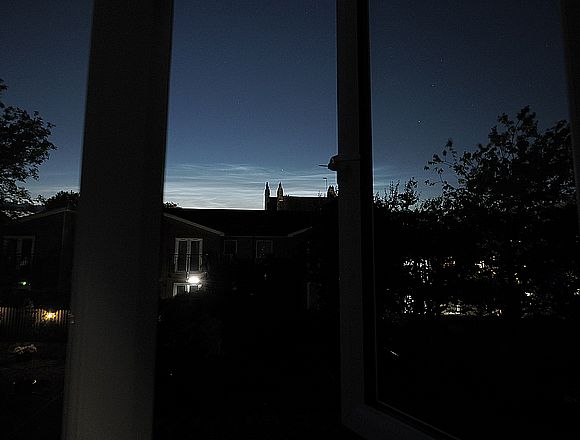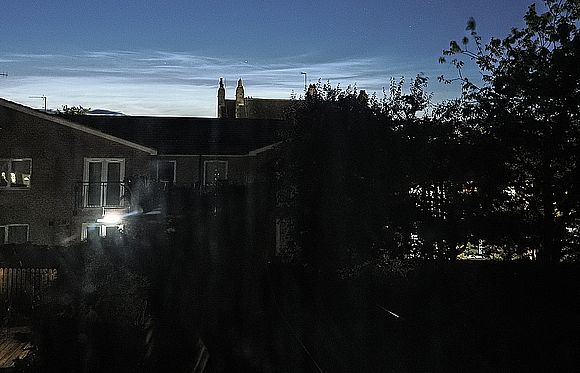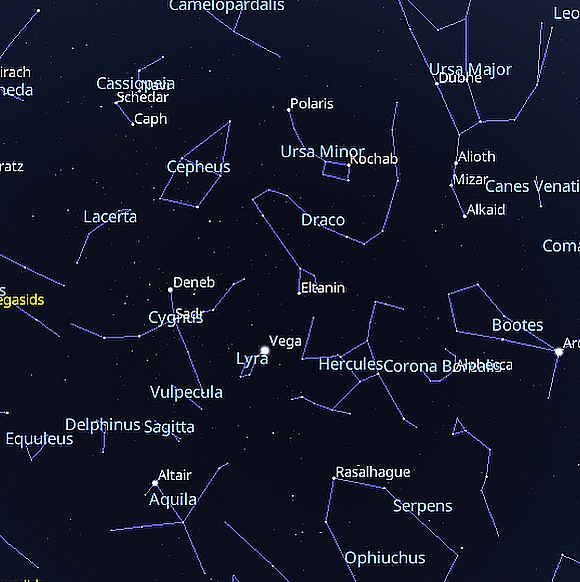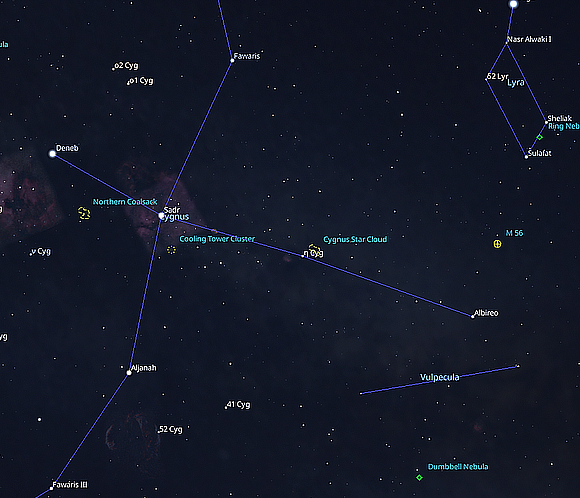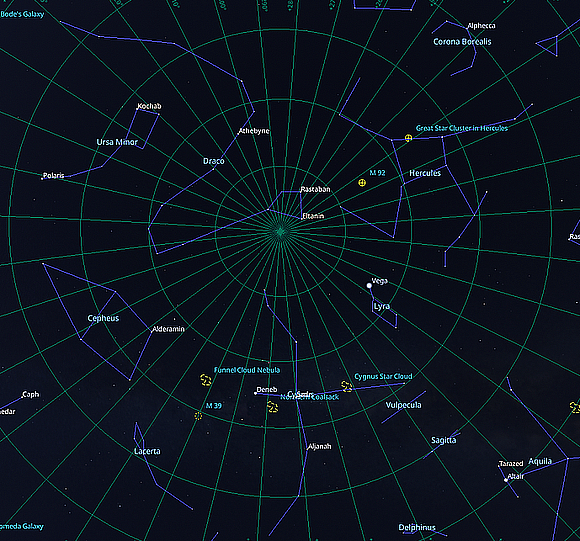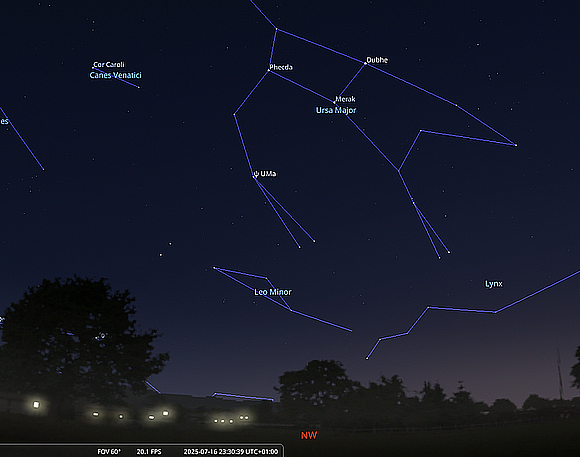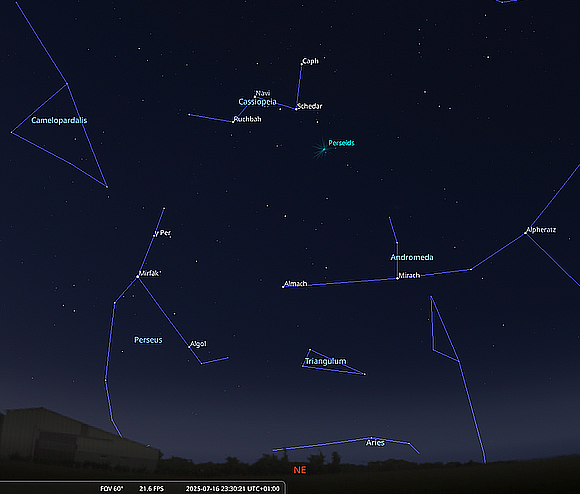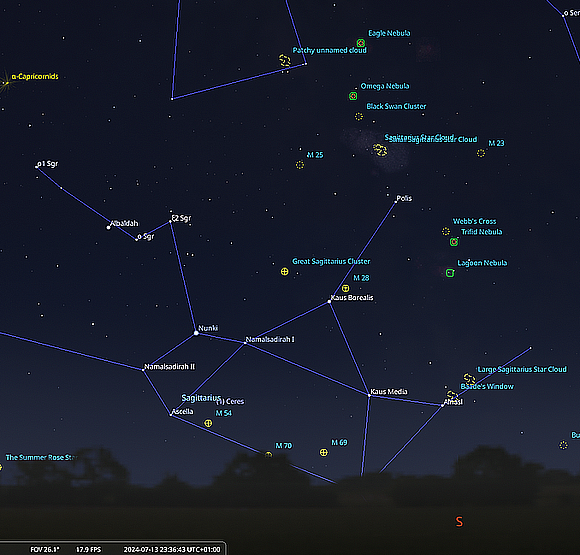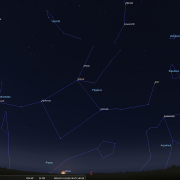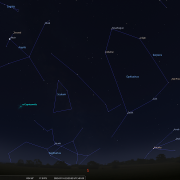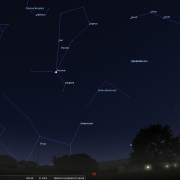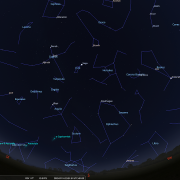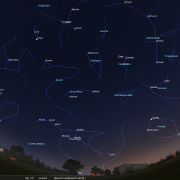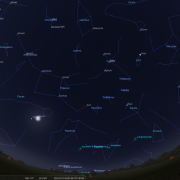In this month's Sky Notes:
- Planetary Skylights
- July Meteors, Aurora and Noctilucent cloud reports
- July Night Sky
- July 2025 Sky Charts
Planetary Skylights: A Brief Guide to July's Night Sky
Planetary observation is primarily reserved for the early morning sky, with Venus and Saturn visible to the unaided eye and Jupiter making its return towards the month's end. Uranus and Neptune are also present in the dawn sky but require optical instruments to identify. Mars, the only evening planet, will exit the evening sky in July.
 Mars should now be considered a ‘lost cause’ as an object of observational interest. Mired in evening twilight low in the west, the red planet will become beyond naked eye detectability after the second week, finally succumbing to the west horizon towards the end of July. Mars will not be apparent in a dark sky for almost a year, playing peek-a-boo with the horizon for many months.
Mars should now be considered a ‘lost cause’ as an object of observational interest. Mired in evening twilight low in the west, the red planet will become beyond naked eye detectability after the second week, finally succumbing to the west horizon towards the end of July. Mars will not be apparent in a dark sky for almost a year, playing peek-a-boo with the horizon for many months.
 Saturn will gradually become easier to spot overnight observable in the ESE around 01:00hrs BST at the beginning of July from UK latitudes. By the month's end Saturn will be rising shortly after 23:00hrs, thus extending the observation window to nearly 5 hours - apparent until 04:00hrs.
Saturn will gradually become easier to spot overnight observable in the ESE around 01:00hrs BST at the beginning of July from UK latitudes. By the month's end Saturn will be rising shortly after 23:00hrs, thus extending the observation window to nearly 5 hours - apparent until 04:00hrs.
Observational 'seeing' conditions for Saturn will improve throughout July as it ascends higher in the sky achieving an elevation of over 22 degrees above the southern horizon by the end of the month. Observers will not however appreciate the familiar vista of Saturn's rings, this being a ring plane crossing year, during which the rings appear edge-on at various times, doing so again in November. The current inclination of Saturn's ring system is approximately 2 degrees. Note Saturn's chief moon Titan as a speck of light in the vicinity of Saturn. Larger instruments, darker skies and better than average ‘seeing’ may also reveal several more of Saturn’s moons.
 Neptune can be located with the aid of a telescope, a reliable star chart, and considerable patience. However, for this month Saturn will be of great aid, Neptune located just one degree above it! View late in the month preferably after midnight. Neptune will appear as a tiny blue/grey disk in a 150mm 6” telescope at medium power.
Neptune can be located with the aid of a telescope, a reliable star chart, and considerable patience. However, for this month Saturn will be of great aid, Neptune located just one degree above it! View late in the month preferably after midnight. Neptune will appear as a tiny blue/grey disk in a 150mm 6” telescope at medium power.
Neptune resides above Saturn for much of July. Chart is for July 24th @ 01:00hrs.
(Click for full image)
 Venus continues to be visible in the early morning eastern sky, however, the 'morning star' won't venture more than a dozen degrees above the horizon throughout July. This morning apparition is therefore below par for observers situated at mid-northern latitudes, the observing viewing window no more than two hours beginning at 02:30hrs. Despite this, at magnitude -4.0, Venus will be bright enough to be visible in dawn twilight for a brief duration. Observations through a telescope will reveal no detail, but observers should note the phase which will increase from 62% at the start of the month to 75% by the end. On July 21st and 22nd, a waning crescent Moon lies near Venus at 03:00hrs BST.
Venus continues to be visible in the early morning eastern sky, however, the 'morning star' won't venture more than a dozen degrees above the horizon throughout July. This morning apparition is therefore below par for observers situated at mid-northern latitudes, the observing viewing window no more than two hours beginning at 02:30hrs. Despite this, at magnitude -4.0, Venus will be bright enough to be visible in dawn twilight for a brief duration. Observations through a telescope will reveal no detail, but observers should note the phase which will increase from 62% at the start of the month to 75% by the end. On July 21st and 22nd, a waning crescent Moon lies near Venus at 03:00hrs BST.
 Jupiter will reappear in the dawn twilight sky toward the end of July. It can be observed just above the ENE horizon shortly before 03:40hrs from the 20th onwards. A very slim crescent moon will be positioned above Jupiter on the 23rd. Additionally, note that by the end of July, Jupiter and Venus will be converging.
Jupiter will reappear in the dawn twilight sky toward the end of July. It can be observed just above the ENE horizon shortly before 03:40hrs from the 20th onwards. A very slim crescent moon will be positioned above Jupiter on the 23rd. Additionally, note that by the end of July, Jupiter and Venus will be converging.
 Uranus is located several degrees below the Pleiades star cluster and will be visible in the early morning hours later in the month around 03:00hrs. At mag +5.7 Uranus is technically visible to the naked eye from a dark location and with use of a star chart or sky app. Binoculars will show it as a speck, but apertures of 80mm plus (3"+) are required to reveal the tiny 3.7 arc-second grey-green disk. Instruments above 125mm (5") will define it more clearly.
Uranus is located several degrees below the Pleiades star cluster and will be visible in the early morning hours later in the month around 03:00hrs. At mag +5.7 Uranus is technically visible to the naked eye from a dark location and with use of a star chart or sky app. Binoculars will show it as a speck, but apertures of 80mm plus (3"+) are required to reveal the tiny 3.7 arc-second grey-green disk. Instruments above 125mm (5") will define it more clearly.
July Meteors and Noctilucent Cloud
Several minor meteor showers occur during July. The Capri-Cornids have three peaks on July 8, 15, and 26, with zenith hourly rates (ZHR) just above sporadic levels. Viewing is best around 02:45 hrs, but the peak on the 15th will be affected by moonlight.
The Alpha Cygnids peak on July 21st, also with rates slightly higher than sporadic levels. Cygnus will be positioned high in the SSE by midnight, though moonlight may affect visibility.
The Delta-Aquarids are somewhat more active, peaking on July 30th with a Zenith Hourly Rate of approximately 15. Moonlight will not interfere.
Noctilucent Cloud Watch
Noctilucent cloud display - midnight June 22/23 2025.
Image - Mark Dawson - Whitby. (Click image for complete view)
Given the fine settled conditions and above average number of clear late evening skies, displays of noctilucent cloud had been rather elusive for most of June, with few sightings. This changed somewhat in the final week with several displays visible, or partly visible. Mark hastily captured a display on June 22/23rd - around midnight low to the north. More displays followed in the run up to July, however cloud banks over the North Sea spoiled complete observations. The NLC season normally draws to a close by the end of July, so remain vigilant!
Noctilucent cloud display - midnight June 22/23 2025.
Mark D took image through window, hand held 0M-1 + 9mm Pani f1.7 lens 2 sec exp
(Click image for complete view)
Noctilucent cloud formations are only seen above the northern horizon at this time of year, often long after sunset around the midnight hour and sometimes into the early morning hour. Its appearance is quite distinct, shining quite brightly, exhibiting a characteristic silvery-blue hue, filamentary in structure. Noctilucent clouds form exclusively between latitudes 50 and 60 degrees north, at an altitude of over 50 miles, five times higher than normal clouds. The cloud forms when water vapour condenses at the low temperatures that prevail at such altitudes onto particles suspended in the air.
There has been considerable auroral activity throughout June, frustratingly more often than not during hours of daylight and hidden from view, so no images.
July Night Sky
July evenings remain light and offer limited opportunities for astronomical observations, but by the end of the month, darker night skies will gradually return providing hope as the extended daylight hours of summer wane.
For those unfamiliar with the summer night sky, identifying celestial landmarks can be challenging due to the persistent twilight and the absence of recognizable constellations before midnight. In these circumstances the brightest summer stars may serve as useful guides, once you have identified them.
Originally like our Sun, Arcturus has now entered an advanced stage of stellar evolution, converting Helium at its core—a process that will continue for approximately another 200 million years. During this phase, Arcturus has expanded to a diameter exceeding 30 million miles (46 million kilometres) and is the nearest 'orange giant' star, located just 37 light-years from Earth. Its distinctive orange hue provides a striking visual through telescopic observation.
In comparison, Vega, which shines brilliantly overhead to the east, exhibits a steely blue lustre indicative of its youth. However, appearances can be deceptive; Vega is already halfway through its lifespan at just 500 million years old. This is due to its mass - Vega is at least twice as massive as our Sun and will eventually evolve into an orange giant star ending its lifecycle as a planetary nebula.
Vega is the brightest member of the 'summer triangle', an asterism comprising three stars: Vega, Altair, and Deneb. The most southerly point of this isosceles triangle is marked by Altair in the constellation Aquila, the Eagle. Altair is the closest of the bright summer luminaries visible from UK shores, located just 16 light-years away.
Conversely, Deneb, situated in the constellation Cygnus, is the furthest (1,500-1,800 light-years) and visually appears less brilliant than the other two members of the triangle (magnitude +1.25). Despite this, Deneb ranks among the top 20 brightest stars visible in the night sky and with a diameter about 203 times that of the Sun is one of the largest known stars in the spectral class A category. Deneb possesses a true luminosity exceeding 180,000 times the Suns and has a mass at least 20 times greater, all resulting in a short stellar life and a spectacular supernova demise 20-25 million years in the future!
One of the few popular Chinese tales associated with the night sky absorbed into western culture involves Vega and Altair, the imperial weaver girl and the lowly goat herder. After falling in love, they neglected their duties and to prevent further interruption to their work the celestial emperor harshly separated them, placing them on opposite sides of the Milky Way. Thereafter, the couple were allowed only to meet one night each summer, the seventh night after the seventh full Moon, when magpies bridged the Milky Way with their wings.
Returning to Arcturus, look for the delicate circlet of stars marking Corona Borealis - the Northern Crown, located upper left of Boötes. Its chief star, Alphecca or Gemma, is reasonably conspicuous set midway along the starry circlet. Astronomers are still waiting for the recurrent nova star T Cor B to erupt - which would be lower left of the circlet, an event occurring roughly every 80 years. Reports suggested March 27th was a likely date, but nothing happened. There is now speculation the outburst may occur at the next 228-day orbital period, which may be Nov 10th. Failing this, T CrB completes additional orbits on June 25th, 2026, and Feb. 8th, 2027. But then again it could erupt anytime! Normally the star is invisible to the naked eye - even binoculars struggle, but when the star finally does erupt it will appear similar in brightness to Alphecca at mag +2.0.
To the left of Corona and high to the South, stands the great hero of mythology, Hercules, a large but ill-defined group. The central asterism of Hercules, known as the 'keystone', resembles the shape of the central stone of an arch. On the right-hand side confine of the Keystone resides the wonderful deep sky object M13 - the great globular star cluster, visible in binoculars as a blurred star, but revealed through modest scopes as a glowing gossamer ball containing upwards of half a million stars 26,000 light years distant.
Above Hercules, the head of Draco is positioned almost directly overhead, with the dragon's body winding between the two celestial bears. Alpha Draconis, also known as Thuban, lies approximately midway between Mizor in the handle of the Plough and Pherkad major and Kochab in Ursa Minor. Although it is only the eighth brightest star in the constellation, its designation as 'alpha' is due to its historical significance; around 5,000 years ago, it was the star nearest to the north celestial pole. The precession of the Earth's axis has since shifted this point to its current location near Polaris in Ursa Minor. It can be found due North, slightly more than halfway up the sky from our latitude, but your own latitude in the northern hemisphere will dictate how high it is in the sky.
To locate Polaris, use the 'pointer stars', Dubhe and Merak, in the 'bowl' of the familiar 'saucepan' outline of the Plough, part of Ursa Major, the Great Bear, which emerge through the twilight around 23:15hrs. It is common for individuals not well-versed in astronomy to mistake the bright star low on the northern horizon at this time of year for the North Star, but Capella, in the circumpolar constellation of Auriga - the Charioteer, should be considered a winter luminary. Capella is the third brightest star visible during the summer months from the UK, after Arcturus and Vega.
Just a short hop to the east from Polaris - midway up from the NNE horizon, the rather faint 'crooked house' outline of King Cepheus holds court. His wife, the more distinct constellation of Queen Cassiopeia is often referred to as the “W” pattern for obvious reasons! When skies become fully dark again in August it’s worth spending time exploring Cassiopeia using optical aid, the constellation contains numerous star fields and clusters. Below Cassiopeia, extending up from the NNE horizon - reaching up toward Cassiopeia is the great hero Perseus, the pattern of which reminds a little of a distorted Pi symbol. The Queen's sacrificial daughter - Princess Andromeda, along with the winged horse, Pegasus, accompany Perseus on his journey into the NE sky.
Although still 'midsummer', these autumn constellations are already making inroads up into the east sky and will eventually take centre stage. Similataneously in the west, the last vestiges of the spring sky are only now departing, Spica, chief star in Virgo doing so in the WSW shortly after 23:00hrs BST.
Much of the SW aspect is occupied by the three large figures of Hercules, Ophiuchus and Boötes which we have previously visited, but just visible above the SSW horizon is the bright first magnitude M class star Antares, chief star in the constellation of Scorpius and one of the most orange stars visible from the UK. It is a pity that from our latitude this constellation only partly rises, the tail and 'sting' stars remaining below the horizon. Scorpius and Antares are only visible for approximately 8 weeks from the UK, and then at best for only 4 hours each night, so it’s not surprising casual observers may miss it completely!
Following the Scorpion across the southern horizon, Sagittarius is best identified by the 'Teapot' asterism, which sits almost on the horizon. It should be noted that the lower part of Sagittarius does not rise above the UK shores, thus many of the numerous deep sky objects (DSOs) within its boundaries are usually observed under suboptimal conditions. However, this does not mean that observers should avoid the Archer; on the contrary, as we will explore next month when Sagittarius is in a more favourable position. Until then make the most of those late evening strolls!
July Sky Charts.
Additional Image Credits:
- Planets and Comets where not otherwise mentioned: NASA
- Sky Charts: Stellarium Software and Starry Night Pro Plus 8
- Log in to post comments

